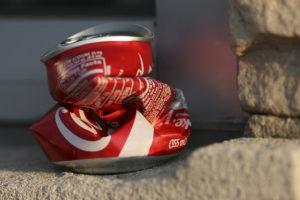Readers of this blog are enlightened about many things that others are unaware of – like the fact that so-called “silver” amalgam fillings are really 50% mercury. But the neurotoxin still shows up in even more surprising places.
A can of soda, for instance.
And for that, you can thank that most common of American sugars, high fructose corn syrup (HFCS).
HFCS & the Sugar Glut

Because obesity rates began their meteoric rise right around the time HFCS was widely introduced, many wondered if there might be some connection. Some thought the body might metabolize it differently than other forms of sugar, and indeed, research suggests that the body handles fructose differently than glucose and other sugars.
But despite its name, HFCS isn’t just fructose. Like ordinary table sugar (sucrose), it’s a combination of glucose and fructose. As noted in the American Journal of Clinical Nutrition, “The glucose-to-fructose ratio in HFCS is nearly 1:1; similar to the ratio in sucrose, invert sugar, and honey.”
The main trouble with HFCS appears more one of overconsumption – and, relatedly, its impact on our sweet tooth. In 2011, consumption was down 16% and at its lowest point since 1997. Unfortunately, sugar consumption rose nearly 9%. Each year, the average American continues to eat about 100 pounds or more of added sugars – a major contributor to all manner of chronic illnesses plaguing our country today.
As Much as 200 mcg of Mercury Each Week
There are other problems with HFCS, as well, such as its source being GMO corn. And then there’s that matter of the mercury. Mother Jones tells the story:
In 2004, Renee Dufault, an environmental health researcher at the Food and Drug Administration (FDA), stumbled upon an obscure Environmental Protection Agency report on chemical plants’ mercury emissions. Some chemical companies, she learned, make lye by pumping salt through large vats of mercury. Since lye is a key ingredient in making HFCS (it’s used to separate corn starch from the kernel), Dufault wondered if mercury might be getting into the ubiquitous sweetener that makes up 1 out of every 10 calories Americans eat.
Dufault sent HFCS samples from three manufacturers that used lye to labs at the University of California-Davis and the National Institute of Standards and Technology. The labs found mercury in most of the samples. In September 2005, Dufault presented her findings to the FDA’s center for food safety. She was surprised by what happened next. “I was instructed not to do any more investigation,” she recalls.
Fortunately, she didn’t listen to them and persisted in her research.
In January [2005], Dufault and her coauthors—eight scientists from various universities and medical centers—published the findings in the peer-reviewed journal Environmental Health. Although they weren’t able to determine what type of mercury was present, they concluded that if it was organic, the most dangerous form, then based on average hfcs consumption, individuals could be ingesting as much as 200 micrograms of the neurotoxin per week—three times more than the amount the fda deems safe for children, pregnant women, women who plan to become pregnant, and nursing mothers.
* * *
The corn-syrup industry claims that no HFCS manufacturers currently use mercury-grade lye, though it concedes some used to. (According to the EPA, four plants still use the technology.) It says that its own tests found no traces of mercury in HFCS samples from US manufacturers, including a number of samples from some of the same sources Dufault tested. But hundreds of foreign plants still use mercury to make lye—which may then be used to make foods for export. Already, 11 percent of the sweeteners and candy on the US market are imported.
 If you’re still looking for a reason to ditch HCFS for good, you need look no further.
If you’re still looking for a reason to ditch HCFS for good, you need look no further.
And if you’re looking for reasons to ditch added sugars all together, here are 143.
Images: Factory by yooperann
& can by Kerry Lannert, via Flickr